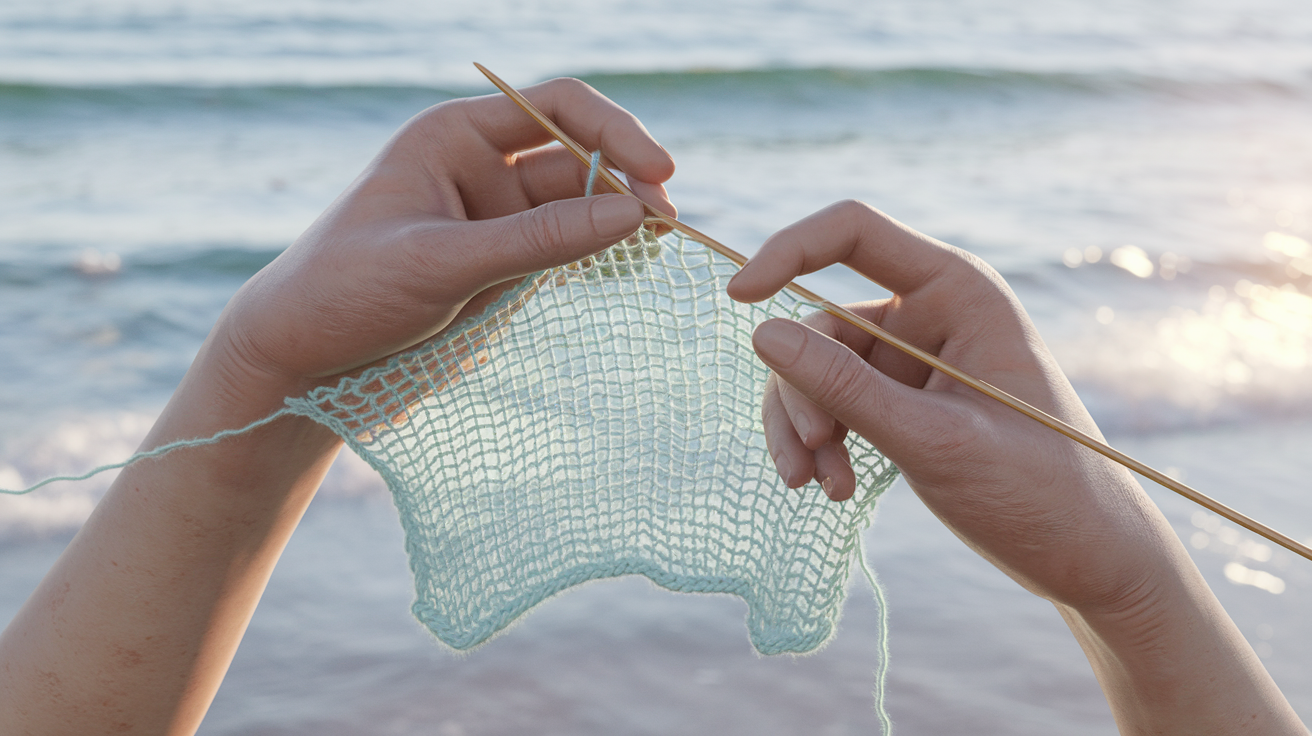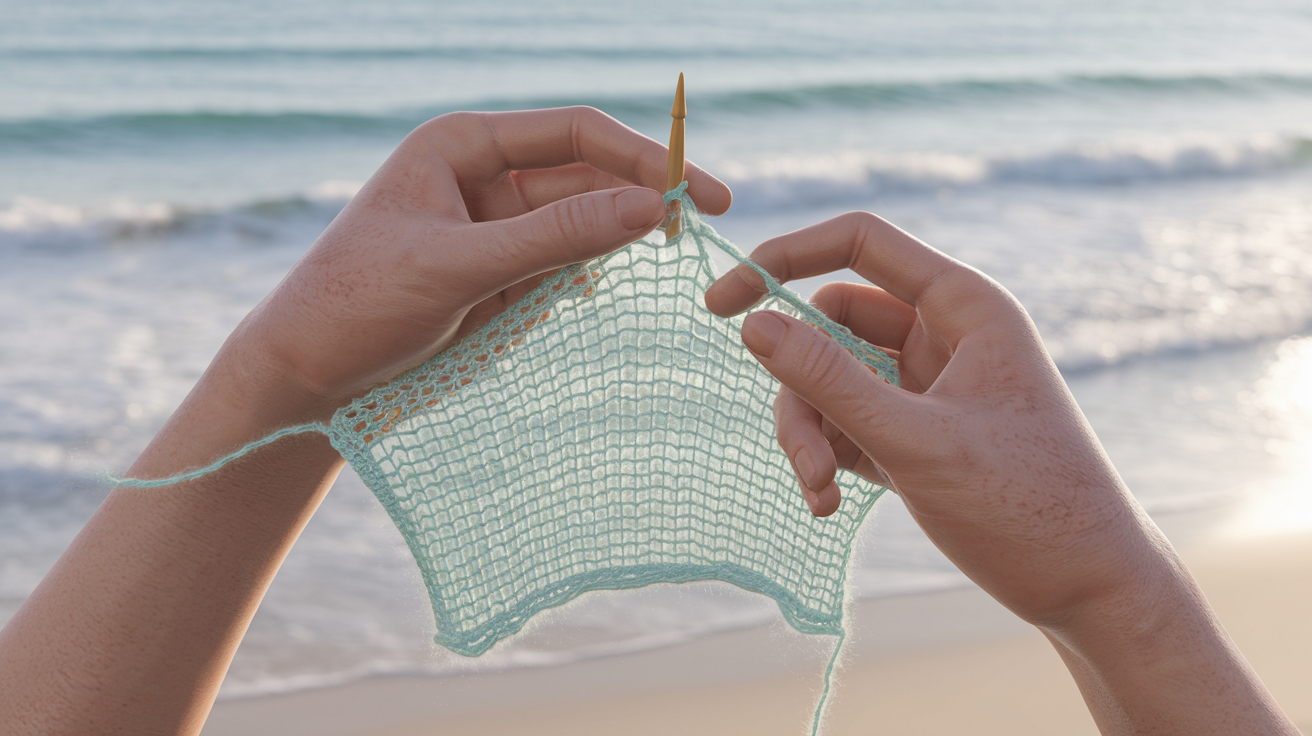How To Crochet A Simple Sleeveless Summer Top Tutorial

Summer crochet top enthusiasts, envision a breezy sleeveless top that’s quick to make, utilizing two simple rectangles joined with neat seams and easy straps for a beautifully customized fit. Our beginner crochet tutorial guides you step-by-step, starting from the bottom: create two flat panels using straightforward stitches like chain stitch, single crochet, or double crochet, ensuring clean lines and simple measuring for a perfect fit.
Opt for cotton yarn or a soft cotton blend yarn to achieve a breathable fabric with excellent drape, ideal for warm weather wear and a lightweight, comfortable sensation.
This two panel construction method minimizes complex shaping while allowing you to easily adjust the width, length, and strap placement.
Finish with tidy borders around the neckline and armholes, then try it on before fastening for an effortlessly wearable DIY garment that’s truly your own. Next, let’s dive into Choosing Your Crochet Yarn.
Choosing Your Crochet Yarn
Yarn selection plays a significant role in the fabric’s drape, its cooling comfort, and how easily it can be cared for—all important factors for a sleeveless top you’ll want to wear all season long.
Cotton yarn offers a naturally breathable fabric with crisp stitch definition, making it perfect for showcasing basic stitches and subtle textural elements. Using DK yarn or a light worsted cotton blend will keep your handmade top lightweight, durable, and simple to maintain with gentle machine wash cycles.
Achieving a consistent crochet gauge is easier with smooth, plied strands that glide smoothly under your hook, resulting in neat rows whether they feature simple or textured stitch patterns.
Your chosen hook size should initially match the yarn label’s recommendation, but be prepared to adjust it after making a swatch to achieve your desired fit and fabric density.
For best results with care tips: always lay your finished piece flat to dry, which helps maintain its shape and beautiful drape.
Fiber Focus: Cotton and Blends
Cotton yarn is an excellent choice for a summer crochet top due to its natural breathability and delightful softness, making it perfect for warm weather wear. The crisp drape of cotton makes stitches pop, ideal for showcasing simple stitches and subtle textures.
Cotton blend yarn, often incorporating linen or bamboo, can offer enhanced drape and a slightly different sheen, further contributing to the garment’s lightweight feel and comfort. When selecting your yarn, consider brands known for quality, ensuring a smooth, plied texture that will glide easily on your hook, aiding in consistent tension control and neat stitch work.
Yarn Weight Guidance
For this sleeveless crochet pattern, choosing a DK yarn or a light worsted weight yarn is recommended, as these weights provide a lovely balance between speed of construction and fabric weight.
This ensures your DIY garment feels light and airy, perfect for layering or wearing on its own during warmer months.
Using a lighter weight yarn also contributes to a beautiful fabric drape, preventing the top from feeling too heavy or stiff.
This choice is part of what makes it an easy crochet project.
Achieving the Right Gauge
To ensure your crochet tank top fits as intended, creating a crochet gauge swatch before starting is essential. Swatch making involves crocheting a small square using your chosen yarn and hook, then measuring your stitches and rows against the pattern’s requirements.
This step helps you understand your personal tension and make necessary adjustments to your hook size if your gauge doesn’t match. Getting your gauge right guarantees your finished crochet clothing will be the correct size, avoiding issues like a too-tight or too-loose fit.
A measuring tape, stitch markers to note your gauge, and a yarn needle are indispensable tools for this process.
Caring for Your Handmade Top
Proper care tips are important for maintaining the beauty and longevity of your handmade top.
Generally, cotton yarn items can be hand-washed or machine-washed on a delicate cycle with cool water.
Always lay the garment flat to dry, using blocking mats and pins if necessary, to prevent stretching and maintain the intended shape and fabric drape. Following these simple care instructions will ensure your stylish summer fashion piece remains a favorite in your wardrobe for seasons to come.
Section>

What Hook Size to Use?
Selecting the correct hook size is pivotal for achieving your desired crochet gauge and the perfect fabric drape for your summer crochet top. Yarn labels offer recommended hook ranges as a starting point for your swatch making.
Cotton yarn, especially DK yarn, often pairs well with hook sizes from 0 mm to 0 mm, but adjust this based on whether you want a lacy effect or a denser fabric.
A larger hook with fine yarn can create an airy, open fabric like filet crochet, while a smaller hook yields a tighter, more structured fabric with clear stitch definition.
Employing a measuring tape to track your rows ensures consistent sizing, preventing guesswork and leading to a more accurate, customizable fit for your handmade top.
- Tip: After creating a swatch making, lightly block it and adjust your hook size to match your intended crochet gauge for a successful DIY garment.
- Aim: Balance the fabric’s drape and coverage to perfectly suit your warm weather wear needs and personal style.
Mastering Basic Stitches
The foundation of any beautiful crochet clothing piece, including your Crochet tank top, relies on consistent tension control of your basic stitches. For instance, single crochet creates firm, stable fabric ideal for edges, while double crochet adds height and speed, contributing to the breathable fabric of a lightweight crochet garment. Practicing a few rows of each stitch until they are uniform will significantly improve your stitch definition and the overall look of your fashion crochet. For added visual interest without overcomplicating, consider the grit stitch, which alternates single and double crochet, or lightly incorporate filet crochet sections for enhanced airflow. It is advisable to use the same hook size used for your gauge swatch throughout the project to maintain consistency. If you notice your fabric becoming too tight or too loose, revisit a quick swatch to re-establish your tension.
- Practice: Work several small practice pieces: commit to 10 rows of single crochet, then 10 rows of double crochet, carefully observing your tension throughout.
- Refine: For a clean finish that avoids puckering prevention, edge your garment’s openings with a relaxed single crochet or a crab stitch.
| Hook Size Range (mm) | Yarn Weight | Fabric Effect | Stitch Definition |
|---|---|---|---|
| 0 – 0 | DK | Lacy or Denser | Clear or Tighter |
| Larger | Fine | Airy, Open (e. g. , Filet Crochet) | Less Defined |
| Smaller | Fine | Tighter, Structured | Clearer |
Creating Your Two Panel Construction
Summer crochet top creation begins with confirming your panel dimensions using a measuring tape, then you will work bottom-up rectangles to match your calculated width and length for a truly customizable fit. Stitch markers placed every 10–12 stitches reinforce tension control, assisting in keeping your edges even and preventing any creeping width changes during rows.
Cotton yarn or DK yarn provides breathable drape; maintain consistent single crochet or double crochet to preserve stitch definition and achieve clean side seams.
This beginner crochet tutorial guidance: recount at row ends to catch any skips, add a light border to square waviness, and test fitting before fastening ensures panels align for seamless crochet assembly and easy joining.
Gauge is important for sizing your crochet tank top; make a swatch to achieve accurate sizing, adjusting hook size as needed.
For example, a gauge of 16 sts × 20 rows = 4 in × 4 in (10 × 10 cm) in single crochet after light blocking is a great starting point. Yarn selection of 100% cotton or cotton-linen blends offers excellent breathability and crisp stitch definition.
Smooth, low-halo yarns enhance stitch clarity, making them ideal for warm climates.
- Panel Width Calculation: Bust measurement + desired ease (typically 2 to 6 inches) divided by
- Panel Length: Measure from the desired hemline to the underarm point.
- Stitch Markers: Use these at regular intervals of 10-12 stitches to maintain consistent panel width and tension control. This is a practical application of stitch control, helping to maintain consistent panel width.
- Edge Consistency: Methods for creating even edges for seamless joining include consistent tension and using stitch markers to guide your stitch count per row.
- Addressing Uneven Width: Potential issues like uneven fabric width during construction can be mitigated by using stitch markers at regular intervals.
Assembling Your DIY Garment Sections
Fashion design principles apply here: align panels with right sides facing, then pin or place stitch markers along hems, underarms, and shoulder seams to avoid any distortion. Crochet techniques that complement basic stitches include a mattress stitch with a yarn needle for invisible structure or a tight single crochet seam for durability and neat lines. Summer crochet top builders should seam from hem to underarm, repeat on the other side, and then join shoulders, leaving armholes open for test fitting. For DIY garment finishing, add neckline edging and armhole finishing with relaxed tension to prevent puckering and maintain the breathable fabric comfort.
The mattress stitch or a tightly crocheted seam can provide a professional and durable join, complementing your chosen stitch pattern beautifully.
- Seaming Sides: Align the two panels right sides together. Seam the sides from the hem upward using a whip stitch or a tight sc seam, leaving armholes open as preferred. This allows for adjustable armhole depth during fitting before fastening.
- Joining Shoulders: If you created a straight, square neckline on both panels, seam the shoulders together. If you plan to add separate straps, you may skip this step or seam only partway.
- Strap Creation: Place markers on the front and back panels where the straps will sit. Attach your yarn and crochet foundation chains to your desired length. Work 1–3 rows of sc over the chains to stabilize them. Alternatively, you can crochet the straps directly onto the front and back edges for extra security and a sturdier feel.
- Edging and Finishing: Work a round of single crochet around the armholes and neckline for clean edges. Keep your tension relaxed here to prevent any puckering. Add a bottom hem edging: 1–3 rounds of sc or a simple crab stitch (reverse single crochet) adds structure and a polished look.
- Customization Tips for Fit: For more ease, add extra width to your panels; for a more fitted look, subtract ease but ensure comfortable armholes. Adjust the panel length by adding rows for a standard tank or subtracting for a crop top.
- A gauge of 16 stitches by 20 rows in single crochet per 4×4 inches is recommended for accurate sizing of a crochet tank top.
- Adding 2 to 6 inches of desired ease to the bust measurement is suggested for a comfortable fit when calculating panel width.
- Using stitch markers every 10-12 stitches helps maintain consistent panel width and tension control during crochet construction.
- Relaxed tension is advised when adding edging to armholes and necklines to prevent puckering and ensure fabric comfort.
Finishing Touches for Straps
Crafting a refined Crochet tank top involves meticulous attention to strap attachment, ensuring both comfort and aesthetic appeal. Let’s explore how to achieve a stable and attractive strap integration for your summer crochet top.
Use stitch markers to precisely map the attachment points on both the front and back panels, promoting symmetry and allowing for a truly customizable fit; always test fitting before permanently fastening your straps to prevent any unwelcome slippage.
Consider various design choices for your straps, from delicate slim spaghetti straps to more supportive cross-back options, or even practical 3–5-stitch bands in single crochet for enhanced load distribution, making it a truly easy crochet project.
To improve durability and prevent stretching on your handmade top, consider reinforcing the strap edges with a double crochet or crab stitch. Integrating your straps by crocheting them directly onto the panel edges provides a remarkably sturdy join and a visually polished transition for your clothing item.
Customizing Your Crocheted Top
Once your straps are securely in place, you can elevate your sleeveless crochet pattern with thoughtful design upgrades, transforming a simple piece into a unique handmade top.
Experiment with border finishing techniques to define the neckline, armholes, and hemline; a contrasting picot edging or a sharp crab stitch can impart modern clean lines to your summer crochet top. Explore texture play by incorporating slim bands of grit stitch or filet crochet to introduce visual interest and enhance airflow without significantly complicating the two panel construction of your DIY garment.
Fine-tune the fit by adjusting strap length and the overall ease for an adjustable sizing approach; wider straps can offer increased support, making this a versatile crochet versatility creation.
Harmonize your yarn choice, perhaps opting for breathable cotton yarn or a soft DK yarn, for a fabric that offers excellent drape and clear stitch definition, perfectly complementing everyday casual wear.
| Strap Attachment Techniques | Customization Options |
|---|---|
| Use stitch markers for precise attachment points. | Experiment with border finishing (picot edging, crab stitch). |
| Consider different strap designs (spaghetti, cross-back, single crochet bands). | Incorporate texture play (grit stitch, filet crochet). |
| Reinforce edges with double crochet or crab stitch for durability. | Adjust strap length and ease for adjustable sizing. |
| Crochet straps directly onto panel edges for a sturdy join. | Harmonize yarn choice for drape and stitch definition (cotton, DK). |
Crafting Your Lightweight Crochet Creation
Caring for Your Lightweight Crochet
Providing essential post-creation advice is a crucial step after all assembly and customization. This ensures your handmade top maintains its integrity, shape, and vibrant color, allowing you to enjoy it through many warm seasons.
Gentle Washing Methods
Crochet tank top pieces thrive with gentle washing; fill a basin with cool water, add a mild detergent specifically for delicates, and swish lightly.
Avoid twisting your summer crochet top or wringing it out, as this can damage the delicate stitches and alter the garment’s shape, particularly sections worked with single crochet or double crochet.
Drying and Storage
Cotton yarn benefits from patient handling; soak your sleeveless crochet pattern briefly, then roll the finished item in a clean towel to absorb excess water.
This method is far gentler than wringing and effectively prevents stretching, preserving the stitch definition of your beginner crochet tutorial project.
For drying, lay the garment flat on a clean, dry towel, reshaping the edges and straps to their intended dimensions. Ensure it dries with ample airflow, away from direct heat or harsh sunlight, to preserve the vibrant color of your cotton yarn.
Preserving Shape and Fit
Proper storage is key to maintaining the form of your DIY garment; store your lightweight crochet piece folded, never hanging, to protect the side seams and strap creation.
Place it in a breathable drawer or bin, perhaps with a light block placed between folds if using blocking mats, ensuring the fabric drape remains consistent. This approach helps prevent unnecessary stretching and indentation, keeping your warm weather wear looking its best.
Maintaining Stitch Definition
Your quick crochet make, perhaps a beautiful fashion crochet item, needs mindful care.
To maintain its texture and the clarity of stitches like the grit stitch or filet crochet, spot clean small marks as they appear.
For a more thorough clean, use a mesh bag for occasional delicate cycles.
This careful approach helps preserve the structure of your handmade top and the integrity of your yarn crafting project.
Reinforcing Durability
When constructing your two panel construction project, using basic stitches like the chain stitch and ensuring proper seam finishing on your side seams and strap creation is important. Adding a neat border finishing and considering a customizable fit through adjustable sizing during assembly results in a piece that holds up well to wear.
For lasting beauty of your crochet assembly, focus on gentle handling during cleaning and drying.
- Gentle washing with cool water and mild detergent is recommended to preserve the integrity of delicate crochet stitches like single and double crochet.
- Avoiding twisting or wringing the garment prevents damage to stitches and maintains the intended shape of the crochet piece.
- Laying the garment flat to dry on a clean towel, with reshaping, is crucial for preventing stretching and preserving stitch definition.
- Folding the finished crochet item for storage, rather than hanging, protects side seams and strap creation from unnecessary stretching and indentation.




